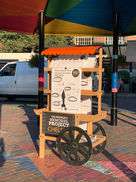People's memorial project
Project Description
"The People's Memorial Project" is more than a public artwork; it is an awareness campaign that addresses the controversial status of monuments and memorials in our country today. It's intent is to generate a conversation about how memorials present one view of history and leave other stories untold. This project provides a glimpse into a future where all peoples who have contributed to the growth and prosperity of our local communities, and the broader nation, are recognized and honored. Who decides who gets memorialized? Why was Christopher Columbus celebrated in so many neighborhoods, including Chelsea? How do these memorials influence and reinforce a vision of who we are and who it means to be an American?
Communities across America are reflecting on who gets remembered, what stories are told, and who is underrepresented or systematically excluded. The process of creating and siting public art is an expression of personal and collective agency. This generation is looking anew at how public monuments frame the story of our country and is seeking out those that remain untold.
"The People's Memorial Project" poses the question: What does it look like to bring those who have been excluded back into the conversation? What would it mean for Black, Latino and other people of color, the poor and other marginalized people to be recognized in our public square? The project opens an accessible, community-based conversation about civic monuments and their role in our community of Chelsea.
In the summer of 2021 the creative team held an introductory conversation. They then conducted outreach to the community, asking for nominations, both contemporary and historic, for recognition.
Five finalists were selected -- Glady Vega of La Colaborativa, Chelsea-born Black inventor Lewis Latimer, Latino boxed John Ruiz, local restaurant workers as personified by Denise Chino, and Chelsea Police Department led by Chief Brian Kyes. For one night at the end of September, full-length portraits of these individuals were projected, hologram-like, atop the plinth that formerly held a statue of Christopher Columbus. Spoken word performances and the community reflection continued.




Presenters











